#aseedtolife
Link
Gardeners in you must be very excited as the spring has begun. I know I’m. I can’t wait to get outside to see new surprises in my garden. All the seedlings have started sprouting and spring flowers are blooming. As the temperatures have started rising, to stay hydrated we can grow some juicy watermelons.

History of Watermelons
Did you know that watermelons are ancient fruits that are being cultivated since prehistoric times? They were growing in wild in the Kalahari desert in Africa. Those fruits were not sweet-tasting like today’s watermelons. They were also found in the tombs of Egypt at multiple archaeological sites. These discoveries show that watermelon was being cultivated since ancient times. Inner green and bitter parts gradually were replaced with red mellow parts by selective breeding and advances in agricultural technology. Seedless watermelons were discovered by Japanese scientist Professor H. Kihara.
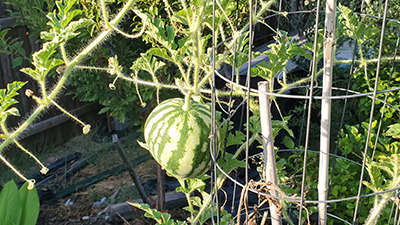
Growing Climate
Watermelons grow well in a tropical and temperate climate. Last year, I grew some baby watermelons in a container. Usually, summer in my region is harsh and the temperature is consistently is above 100°F. It affects even heat-loving plants like watermelons. But last year, I installed a quick homemade trellis in a 17-gallon container and I could enjoy a refreshing harvest.
The benefits of growing watermelons in containers
You can control the amount of space it occupies and also the amount of water. Watermelons like consistent watering. Perfectly watered watermelons are sweeter in taste with juicy pulp.
Also, you can protect the plants better by covering them using either a tarp or shade clothe during constant rain and extreme summer heat if the plant is contained.
Keeping watermelon plants potted and growing them vertically also saves a lot of space. Planting them in the ground occupies a considerable amount of space since if grown directly in the ground the recommended spacing between two plants is about 6 feet. If you have a big yard then it is not a problem but for urban gardeners, potted plants work the best.
The plant is a creeping branching vine. The tendrils are the coiled structures that easily grab onto the trellis helping the vine grow upwards. With the plants wrapping around on the trellis, a beautiful vertical structure can be created in the garden. The vines still can get unruly like a toddler and try to wrap onto the branches of the adjacent plants. So you may need to keep guiding them and if you choose a big fruit variety you may even need to support the fruit to ensure that it doesn’t break off of the vine.
When grown vertically in containers, it is easier to protect fruits from animals. I have seen a friend of mine was growing watermelon and rodents used to nibble on the fruits.
Growing Watermelons in the Ground
When grown in the ground watermelons can act as a ground cover, somewhat like a mulch, and retain moisture in the ground. The fruits may need extra protection to keep them dry. You can use some straw, cardboard or readymade stands to keep them away from the ground and getting damaged by moisture.
The harvest is definitely bigger if watermelons are grown in the ground as plants can grow unrestricted.
You can grow bigger varieties easily in the ground.
Why choose a Small Fruit Variety?
If you have decided to grow watermelon in containers then I would recommend picking a small fruit variety like baby watermelons. They mature faster compared to the regular varieties.
If you have a small family then it is better to grow these tiny varieties because you don’t have to worry about storing the leftover fruit after cutting it open.
If you want to avoid sweet fruits for some reason then smaller fruits are better for potion control.
Soil Requirement/ Sun Requirement/
Watermelon like the soil well-draining sandy loam and moist with pH between 6–7 i.e. slightly acidic. Watermelons are heat and sun-loving plants.
Optimal Temperature
They are not at all cold tolerant. They do not well when the temperature drops down to 50°F and below. At these lower temperatures, plants may survive but the fruit doesn’t mature. The optimal temperature for growth is 65–95°F. I live in Texas where summers are exceptionally hot and the temperatures are in the mid to high hundreds and it is normal to have heat waves lasting up to a week or more at a time. In my zone, i.e. zone 8, Watermelon plants do well from spring-early summer and then again late summer-early fall in my region. During the extreme heat of summer, the leaves start drying up and turn yellow. You might even feel that they are not going to survive the summer but they recover as soon as the temperature starts dropping down.
Watering Needs for Watermelons
Watermelons need a good amount of water and nutrients to keep growing as they also grow a lot of foliage too. During summertime, I keep pruning the leaves to divert all the nutrition towards growing fruits.
When to Start the New Plants
Now let’s see when to start the plants. If you have a short summer in your region then you can start the seedlings indoors in late winter, about 6–8 weeks before the temperature in your region reaches about 70°F. At that time they will be ready for transplanting outdoors.
Or start the plants directly outdoors 2–3 weeks after the danger of the frost is over and the temperature is consistently warm. The seed to harvest time for watermelon is approximately 80 days. It is longer for the bigger varieties.
What to feed the plant to get the best fruits?
In the initial period, I want the plant to mature faster so I feed fish fertilizer every 2 weeks for a couple of months and also when I transplant the plants in the final spot I add a mixture of blood and bone meal to provide both nitrogen and phosphorus so that the fruit-bearing and maturation occurs. I also add some azomite to give my plants complete nutrition. The blood and bone meal are long-term fertilizers and I start seeing their result in about 2 months after the application. I frequently feed some compost to my plants.
Are Watermelons Annual or Perennial Plants?

Watermelons are annual plants so you have to start them every year. They can easily be grown from seeds. Unlike a longer growing period, germination time is much shorter, usually between 3–10 days. You can see healthy seeds sprouting only in a couple of days. This year, I’ve decided to grow some of the germinated plants in a raised bed. I’m still planning to grow them vertically though.

Parts of the Watermelon Plant
Roots
Watermelon has a taproot system and the roots are delicate. It matters more when you grow the seedlings in some pot and then try to transfer it in the ground. They can easily get damaged especially while separating the seedlings and if you are not gentle with them while planting.
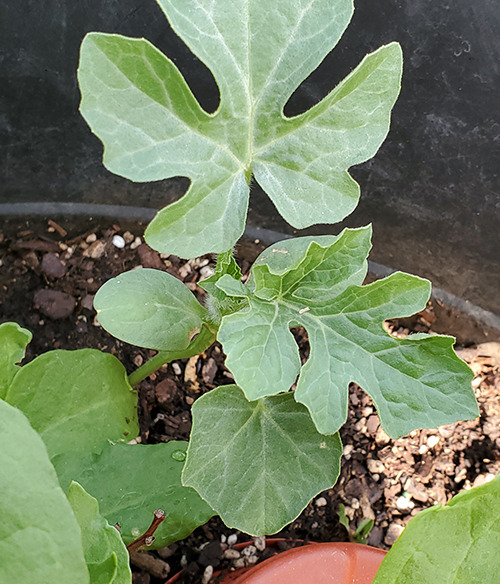
Leaves
The leaves are partitioned into several parts and look very attractive. But they also attract several pests like aphids, cucumber beetle and several other. Beneficial insects play a key role in taking care of the plants in a safe way. I keep removing the dead and yellow leaves during summertime to reduce the energy needs of the plant.
The stems are covered in hairy structures and they branch. They also have coiled structures on their stems called tendrils that help the plant get support.
Flowers

Flowers start developing after about a couple of months. At first predominantly male flowers develop and once the plant is mature enough to bear fruits, both female and male flowers appear. It is not hard to distinguish between male and female flowers. female flowers have a small fruit-like structure under the flower. If the pollination is successful this tiny fruit becomes a mature fruit. It takes another 1 1/2- 2 1/2 months for the fruits to get ready for the harvest.

How do you know that the watermelons are ready for picking?

It can be tricky to know if the watermelon is ready to be picked or not. If you wait too long then the fruit might fall off from the vine or if picked early, it may not reach its maximum level of sweetness. I keep checking on the fruits mainly the tendril near it. Once the tendril turns brown, you can harvest the fruit. Waiting longer even after the harvest makes the watermelon much sweeter. You can see here the skin is very thin and the fruit is very juicy.
Watermelon Nutrition
About 92% of the watermelon is water. The rest is mainly carbohydrates mainly sugars, anti-oxidants, vitamin A(31%), vitamin C (37%), vitamin-B 6 (5%), and Magnesium (7%). It contains very little proteins. The fat co
#seed to life#aseedtolife#wateremelon#verticalgarden#vertical gardening#watermelon in container#container gardening
1 note
·
View note
Link
Shatavari is an ancient medicinal herb. it is most famously known as the Queen of Herbs.
0 notes
Photo

Elephant Foot Yam Plant- Plant Information, Health Benefits, and Growing Requirements
https://youtu.be/flM-scrJOTc
0 notes
Link
0 notes
Link
A plant that is used not only by humans but animals also. Let's explore the important health benefits of the Bitter Leaf plant. Not very famous in the USA but this plant is recognized for its several medicinal benefits in Africa. In this video, I'm sharing with you the health benefits, uses, growing requirements, and if you can even accompany me while I'm preparing the healthy African Bitter Leaf soup for the first time.
0 notes
Link
The Real Brahmi- The Brain Tonic
Bacopa monnieri vs Centella asiatica
Brahmi is famously known as Brain Tonic because of its memory-boosting properties. Phytomedicines in Brahmi are known to have several health benefits. But if you try to google for Brahmi, you will see two different plants come up with the same name. So which one is real Brahmi, the brain tonic?

Centella asiatica
This is Centella asiatica. It is also known as Gotu Kola, Brahmi, Indian pennywort, and Asiatic pennywort. But is it the real Brahmi? The answer is no. Even though both Centella asiatica asiatica and Bacopa monnieri plants are medicinally important they are different species.
Bacopa monnieri Brahmi Plant

This second plant is the real Brahmi. Its scientific name is Bacopa monnieri but it is also known as waterhyssop, Brahmi, thyme-leafed gratiola, herb of grace, Indian pennywort. This is the real Brahmi plant.
Both these plants are found almost worldwide. They are present in Africa, North America, South America, Asia, Australia, Europe

Health Benefits Centella asiatica vs Bacopa monnieri
Many traditional remedies use Brahmi as a brain tonic to improve memory and are added to various dietary supplements. Some animal studies indicate that the long-term supplementation with bacosides showed therapeutic value against the rapid degeneration associated with Alzheimer’s disease. Brahmi may be useful for encouraging liver function following toxin damage. It also reduces gastric ulcers and promotes healing of wound healing. There are studies that indicate the efficacy of bacoside present in Bacopa monnieri in protecting newborns from hypoglycemia-induced brain damage. Researchers have discovered that bacosides also may be helpful for enhancing the benefits of morphine while reducing the “high”, thus decreasing the risk for dependence offer protective benefits for organs commonly affected by opiate toxicity.
Centella asiatica or Gotu kola, like Brahmi, is also considered to increase brain power. Some studies indicate that the phytomedicines in Gotu kola help to curb lung cancer cells due to their antiproliferative properties.
Both these herbs are rich sources of antioxidants and contain calcium, vitamins, and microelements.
Here I would like to share something with you. You must be seeing many companies worldwide are selling products containing these ancient herbs. These herbs are processed and packaged in powder, tablet, or liquid forms. The amount in these medicines or the way it is processed is not always reviewed by FDA. So it is really hard to know if these formulations are completely safe.
The other thing is both these plants are aquatic or semiaquatic. If you want to use them as food or medicine, it is important that you try and grow them organically. Aquatic plants absorb the pollutants in the water very easily and hence if it is grown in water polluted with chemicals then it might do more damage than help.
Toxicity
Centella asiatica/ Gotu Kola (Toxicity)
Gotu Kola contains a phytochemical saponocide that includes Brahmic acid. The chemical is found to cause infertility in both humans and rats. For epileptic patients on medication, it can interfere with the effects of the medicines reducing the efficacy of the epilepsy medicines. Similarly, patients taking diabetic medication also have to be careful while taking such herbal medicines as they tend to affect the blood glucose level. Excessive consumption of Gotu Kola can cause headaches and transient unconsciousness. Consuming Gotu kola for more than 6 weeks can lead to abortion. Some people may be allergic to Gotu kola and develop rashes on contact.
Bacopa monnieri Toxicity
There is only limited research available on the toxicity of Bacopa monnieri and it either doesn’t prove any toxicity or there is insufficient research to find out any other possible side effects or toxic dosage. But again, we know that anything in excess is toxic.
Differences in Taste
Tastewise, they are quite different. Bacopa monneri doesn’t have any taste. It is included in various dishes such as salads, refreshing juices, sambol/ chutney, and also in a stir fry.
The real Brahmi plant is bitter-tasting and used for mainly medicinal purposes. But still, it is also used in stir fry and juices in various Indian recipes.
Differences in Appearance
Now that we have seen the benefits of both these plants, let’s see how these plants look different in appearance.
Both Centella asiatica and Bacopa monnieri grow in marshlands. That means they love water and creep on water or wetland.
The stems and roots of Centella asiatica are sturdier than Bacopa monnieri. Brahmi has very delicate stems. So you have to be more careful while handling them.
Leaves of Centella asiatica are perfectly round in shape and BMoblong or oval in shape.
Gotu kola flowers appear in clusters and they are tiny white to light purple in color.
Brahmi on the other hand develop single flowers. They are also white to purple in color.
Seedtolife
youtube
#bacopamonnieri#brahmi cenetellaasiatica waterhyssop indianpennywort aseedtolife seedtolife brahmitoxicity gotukola
0 notes
Link

To subscribe to my channel click here: https://www.youtube.com/seedtolife?sub_confirmation=1
0 notes
Text
Ancient Medicine Rosary Pea | Gunja | Seed Germination | Toxicity Symptoms | Medical Benefits
Famously known as Gunja/ Rosary pea is an ancient medicinal plant, a poison, and very invasive. The botanical name of this plant is Abrus precatorius. I remember we used to call the gunja seeds rabbit's eye because of the beautiful red color they looked like rabbit’s eyes.
Other Names of Arbus precatorius are
Rosary peas
Gunja
Crab’s eye
Indian Licorice
Jequirity bean
Precatory bean
Saga
Gunchi
Rati gedi
Weglis
Other than having medicinal uses rosary pea is also used for making jewelry and as an ornamental plant. It produces very beautiful shiny seeds. Different varieties of rosary pea produce different colors like red, green, black, white, and one with the red seeds with black eye… somewhat like black eye peas. These beans are not as big as black eye pea. They are about 6–8 mm in length.
Rosary pea contains a toxin called arbin that is present in the seeds. Arbin is similar to the poison ricin and is also found in the seeds of the castor beans. The chemicals in arbin, prevent protein synthesis, which means it stops our body cells from making food… the proteins that are the building blocks of our body. The seeds are protected by a hardcover so accidentally ingesting a seed may not affect a person if the seed is not digested. It will just pass out through stools. But chewing these seeds is very dangerous.
There is no antidote for arbin. Only supportive treatment is given if the poisoning occurs. In a normal situation, it is hard to get arbin poisoning accidentally. But it may be used for intentional poisoning of animals or humans. It was historically used as a poison for malicious purposes. We are not going to see how exactly. But let’s look at the symptoms of arbin poisoning.
The poisoning can occur by breathing, swallowing, or injecting arbin into a person. Symptoms of arbin poisoning depend on the mode of entry. If inhaled, arbin can cause cough, fever, tightness in the chest, and pneumonia, and finally low blood pressure and respiratory failure can occur.
Ingestion of arbin can cause vomiting, diarrhea, bloody stools, severe dehydration. A person may also get seizures, hallucinations, blood in the urine, and then failure of vital organs like kidneys, spleen, liver, etc.
If the arbin powder goes into the eyes, it can cause redness of the eye and pain. If the dose is lethal then a person can die, not immediately but in 36–72 hours.
So now you can understand why it is important to have enough information about any plant that we want to grow.
Link to CDC website for more information.
Medical Benefits of Rosary Pea/ Gunja
Now, are rosary pea plants are that bad?
It depends on how you use it. They have been part of the Indian Siddha medicine since ancient times and are known to cure numerous health issues. Currently, they are used in medical research because they have the potential to kill cancer cells. Traditionally the leaves, roots, and seeds are used for medicinal purposes. They were used to prevent tetanus and rabies.
Gunja seeds are also used as a remedy for various skin conditions like pimples, sores, infections, wounds caused by animals, and leucoderma that are the white patches on the skin. The leaves of the herb are used to cure fever, cough, and cold. The decoction of roots was used to treat liver diseases like jaundice. Gunja seeds are aphrodisiac and also were used as a natural contraceptive.
Distribution
Gunja plants were present in Asia and Africa, but now they are distributed widely across the world and are considered as very invasive species. Now, that I know how dangerous the seeds can be and the invasiveness of the plant, I’m going to keep it potted that too away from other plants. I don’t have any pets but my son is very curious.
Germination of Rosary Pea Gunja Seeds
Now, let’s start the germination.
Here are some Gunja seeds.
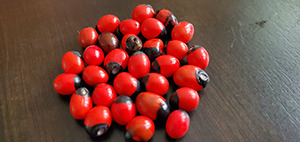

The first step is to soak the seeds in water overnight.

The healthy seeds have become lighter by absorbing water and their outer shell is opening up.

You can wash them gently with water and then wrap them up in a wet and clean piece of cloth. Instead of wrapping it in a cloth, I suspended the seeds in this container by placing them on the wet cloth and closed the lid. The cloth position was adjusted such that it barely touches the water. The cloth absorbed the water and kept the humidity very high inside. You can simply wrap them up with a wet cloth if you want. We just need to make sure that the seeds stay uniformly moist but not completely soaked.

In about 2–3 days the seeds are sprouted. I’m going to sow these germinated seeds in a growing media.

I’m using a seed starting mix. I placed the seeds on the growing media and gently covered them up with about ¼ inch of soil. I prefer sowing them superficially to make it easier for the tiny plants to come up. I’m going to place this cup outside. The temperature fluctuates a lot in my region throughout the day so I’m going to cover it up with a plastic zip-lock bag and secure the bag with a rubber band.
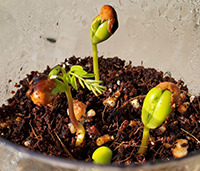
In just 5–7 days these cute seedlings emerged. Their leaves look very similar to tamarind leaves.
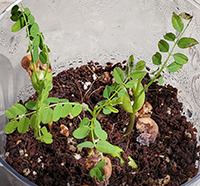
It has been 14 days. Seedlings are growing fast and they are quite sturdier than some other seedlings that I have.


It is time to separate the seedlings. I can directly plant them in a bigger pot now but, I still haven’t decided on their final spot. Gunja is a vining plant and at this point, I’m just separating the seedlings so that they have enough space and nutrition until I decide their final location.
#aseedtolife #seedtolife #gunjaseeds #arbusprecatorius #rosarypea #crab’seye
1 note
·
View note